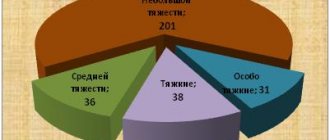Goals and types of punishment
First of all, it is necessary to talk about the role of punishment in the fight against crime.
Unfortunately, in connection with the increase in crime, the tendency in the public consciousness, already known in world history, to believe that crime can be fought by tightening punishment is quite clearly manifested. This position is erroneous.
The entire history of the development of human society shows that with the help of cruel punishments it has never been possible to cope and successfully fight crime. Much more important here is the inevitability, the inevitability of punishment, and not its cruelty.
The role of punishment in the fight against crime
What role does punishment play in the fight against crime?
Far from being the main one, and even then only auxiliary, since in the fight against crime, preference should be given to measures of an economic, political, cultural and organizational nature.
Punishment is a last resort and should be used only when preventive measures have proven ineffective. Even Montesquieu, and then Beccaria, more than two centuries ago, formulated the idea that a legislator, wise by experience, would better prevent a crime than be forced to punish for it later.
Punishment should only be applied when all other remedies have been exhausted. After all, no one has yet proven what punishment is: good or evil?! Apparently both at the same time. It all depends on in what terms it is considered and in what relation it is placed with other social values.
Goals and types of punishment
Signs of punishment
What is punishment and what are its signs?
In Part 1 of Art. 43 of the Criminal Code of the Russian Federation states: “Punishment is a measure of state coercion, imposed by a court verdict. Punishment is applied to a person found guilty of committing a crime and consists of deprivation or restriction of the rights and freedoms of this person as provided for in this Code.”
The main signs of punishment are:
- punishment is primarily a measure of state coercion;
- punishment is a measure that is applied only for a crime;
- punishment is applied only by court verdict;
- punishment is applied in order to restore social justice, as well as to correct the convicted person and prevent the commission of new crimes (Part 2 of Article 43 of the Criminal Code of the Russian Federation);
- in punishment - a pronounced negative assessment of both the crime and the person who committed it. Punishment states a negative assessment on the part of the state of both the criminal act and the convicted person himself.
When applying punishment, one must always proceed from two main directions in criminal policy.
- Application of strict punishments to persons who have committed serious crimes and repeat offenders;
- Application of more lenient punishments, that is, punishments not related to the isolation of a person from society, or even suspended sentences, and sometimes exemption from punishment of persons who have committed crimes that do not pose a great public danger, that is, less serious ones, or those committed for the first time.
The content of these two main directions should determine the criminal policy of our judicial authorities. The punishments provided for in the Criminal Code of the Russian Federation form a certain system.
The punishment system is an exhaustive list of punishments established by criminal law, binding on the court, arranged in a certain order and in a certain relationship with each other.
Goals and types of punishment
Concept and signs of criminal punishment
According to Part 1 of Art. 43 of the Criminal Code, punishment is a measure of state coercion, imposed by a court verdict. Punishment is applied to a person found guilty of committing a crime and consists of deprivation or restriction of the rights and freedoms of this person as provided for in this Code.
In this definition, the legislator indicated the following signs of punishment.
1. Punishment is a measure of state coercion.
The concept of measure means that any punishment has a certain content and quantitative boundaries. For example, arrest is established for a period of one to six months (Part 1 of Article 54 of the Criminal Code), and imprisonment for a term of from two months to twenty years (Part 2 of Article 56 of the Criminal Code). The articles of the Special Part of the Criminal Code for the commission of certain crimes establish specific terms of arrest or imprisonment, which do not go beyond the limits indicated in Art. 54 and 56 of the Criminal Code. When imposing a punishment, the court does not have the right to go beyond the limits of the quantitative and qualitative characteristics of punishments established by the article of the Criminal Code.
The concept of “coercion” means that the criminal is forced:
a) to comply with the law; b) serving a sentence, that is, undergoing deprivations, restrictions and hardships included in the content of punishment.
The coercive measure is state, that is, the subject of the application of criminal punishment is the state represented by the court.
Punishment involves coercion, but it is not coercion.
Coercion is a condition for the implementation of punishment. The court sentences the offender to punishment, the execution of which is ensured by state coercion. For example, a person deprived of his liberty is forcibly taken to a correctional institution and kept there. Coercion means that the convicted person is forced to endure certain hardships and hardships against his will and desire. Therefore, it would be more correct to define punishment as a measure of criminal legal influence.
2. Punishment is a restriction or deprivation of the rights and freedoms of a person.
It should be noted that punishment may also consist of imposing certain burdens on a person, for example, when assigning forced labor (Article 53.1 of the Criminal Code).
Unlike administrative punishment, criminal punishment consists of a significant (greater in size, force) restriction or deprivation of the rights and freedoms of the convicted person.
In Part 1 of Art. 20 of the Criminal Code of the RSFSR of 1960 stated that punishment is punishment for the crime committed. In the current Criminal Code of the Russian Federation, the legislator did not use the concept of punishment, since punishment is not retribution for a crime committed and does not serve the purpose of punishing the perpetrator.
3. Punishment must be established by criminal law.
4. Punishment is imposed by a court verdict on a person found guilty of committing a crime - the object of punishment.
It means that:
- The criminal punishment imposed on the person must be indicated in the court's conviction. This feature is a criminal procedural one, but not a criminal law one, and therefore it can be found in Art. 43 of the Criminal Code shall be excluded;
- If a person’s guilt in committing a crime has not been established, then punishment should not be applied to him, no matter what danger this person poses to society. This feature is also a criminal procedural one;
- the basis for applying the punishment is the commission of a crime by an individual;
- Criminal punishment cannot be applied to a person who has committed other offenses.
According to A.L. Tsvetinovich, the next sign of punishment is that it expresses a negative assessment, censure of the crime and the personality of the person who committed it by the court on behalf of society and the state. It seems that a negative assessment of what was done and condemnation of a crime consist of qualifying the crime and finding the person guilty of committing it, but not in punishing it. Punishment is punishment, but not evaluation and censure.
Some lawyers believe that a criminal record is a sign of punishment, since it is a legal consequence inherent only in criminal punishment. However, a criminal record is not a sign of criminal punishment, since: firstly, it is a legal consequence of the imposition of punishment; secondly, it lies in the special legal status of the convicted person, which in its legal nature differs significantly from the nature of criminal punishment.
Contents of punishment. M.D. Shargorodsky believed that the content of punishment is punishment and education, since if punishment is applied without education or if education is applied without punishment, then there is no punishment.
It seems that education is not included in the content of criminal punishment, since punishment is a means of education.
The content of punishment forms a specific volume of deprivations, restrictions, and hardships inherent in a certain punishment. For example, deprivation of certain rights and freedoms is typical for arrest (Article 54 of the Criminal Code), imprisonment for a certain period (Article 56 of the Criminal Code) and life imprisonment (Article 57 of the Criminal Code). The content of the punishment in the form of restriction of freedom (Article 53 of the Criminal Code) is formed by the following restrictions: not to leave the place of permanent residence (stay) at a certain time of the day; do not visit certain places; not to travel outside the territory of the relevant municipality, etc. Hardships are, for example, compulsory work, which consists of the convicted person performing free socially useful work during his free time from his main work or study (Article 49 of the Criminal Code).
The form of punishment is the type and amount of punishment. For example, the form of punishment provided for in Art. 53 of the Criminal Code is a restriction of freedom imposed for a period of 2 months to 4 years as the main type of punishment for crimes of minor gravity and crimes of medium gravity.
The social purpose of punishment is that it is necessary for the state and society, firstly, as a means of protecting the state and society from dangerous attacks on established social relations, fighting crime and eliminating obstacles in solving political, economic, social and other problems, in -secondly, to correct criminals.
By applying punishment, it is possible to prevent and inhibit unwanted, harmful forms of human behavior, since it has a terrifying effect on the psyche, consciousness and will of people.
However, criminal punishment has never been the main and main means of combating crime. Measures to combat the social causes of crime eliminate those external, objective causes and conditions that give rise to incentives and motives of behavior that are harmful to society and the state. Punishment cannot do this, which is why it is an auxiliary and not the main means of combating crime.
The difference between criminal punishment and other legal measures:
1) criminal punishment is the legal consequence of a crime only, and other legal measures are applied for offenses that are not crimes;
2) criminal punishment has a higher degree of punishment than administrative, disciplinary and other sanctions;
3) criminal punishment is imposed by a court verdict on behalf of the state. Administrative penalties are imposed on behalf of an official or government body. Disciplinary measures are assigned in the order of subordination.
Types of punishment
According to the current legislation, the following types of punishments can be applied to persons found guilty of committing a crime (Article 44 of the Criminal Code of the Russian Federation):
- fine;
- deprivation of the right to hold certain positions or engage in certain activities;
- deprivation of a special, military or honorary title, class rank and state awards;
- compulsory work;
- correctional work;
- restriction on military service;
- restriction of freedom;
- forced labor;
- arrest;
- detention in a disciplinary military unit;
- imprisonment for a certain period of time;
- life imprisonment;
- the death penalty.
Groups of punishments according to the method (order) of their administration
According to the method (order) of their administration, punishments are divided into three groups: basic, additional and mixed.
Basic punishments
Basic punishments are those punishments that are assigned as main, independent punishments and cannot be assigned as additional to other types of punishments.
According to current legislation, these include: compulsory, correctional labor, restrictions on military service, forced labor, arrest, imprisonment for a certain period, life imprisonment.
Additional penalties
Additional punishments are those punishments that cannot be imposed independently, but only as an addition to the main ones. Additional penalties include: deprivation of a special, military or honorary title, class rank and state awards, confiscation of property.
Punishment - concept, types. Aggregation and relapse of crimes.
Punishment - concept, types. Multiplicity of crimes. Recidivism of crimes. Set of crimes.
The concept of criminal punishment is revealed in Art. 43 of the Criminal Code of the Russian Federation, from which it follows that punishment is a measure of state coercion imposed by a court verdict against a person found guilty of committing a crime and consists of depriving or restricting the rights or freedoms of this person. Punishment has three goals : restoration of social justice , correction of the convicted person, and prevention of new crimes.
Article 44 of the Criminal Code of the Russian Federation defines the types of punishment , and Art. 45 of the Criminal Code of the Russian Federation, such punishments are divided into basic and additional , and the rules for applying punishments to the main and additional types are determined. Thus, as only the main types of punishment, compulsory labor, correctional labor, restrictions on military service, forced labor, arrest, detention in a disciplinary military unit, imprisonment for a certain period, life imprisonment, and the death penalty are applied. A fine, deprivation of the right to hold certain positions or engage in certain activities, restriction of freedom, can be applied both as main and additional types . But deprivation of a special, military or honorary title, class rank and state awards is applied only as an additional type of punishment .
Multiple crimes are the commission of more than one criminal act by one person, each of which is an independent crime. When there is a plurality of crimes, there are such signs as: each crime contains an independent crime, all acts retain legal consequences. Currently, the Criminal Code contains such forms of plurality as aggregation of crimes and recidivism of crimes, as defined by Art. 17 of the Criminal Code of the Russian Federation and Art. 18 of the Criminal Code of the Russian Federation, respectively.
Thus, aggregation of crimes is the commission of two or more crimes, for none of which the person was convicted. A set will also be one action containing signs of two or more articles of the Criminal Code, except if any signs of this act are circumstances entailing a more severe punishment (qualifying signs that form an independent crime). That is, if, for example, arbitrariness was committed (Article 330 of the Criminal Code of the Russian Federation) with the use of violence (a qualifying characteristic provided for in Part 2 of Article 330 of the Criminal Code of the Russian Federation), a set of crimes under Part 1 and Part 2 of Art. 330 of the Criminal Code of the Russian Federation will not be, liability arises only under Part 2. And if, for example, a conscript soldier commits an act such as desertion (unauthorized abandonment of a unit in order to evade Article 338 of the Criminal Code of the Russian Federation) and when leaving a unit from the armory room, this subject stole a combat assault rifle and disappeared with it, there will be one act, but the totality of crimes will occur as under Art. 338 of the Criminal Code of the Russian Federation Desertion, and under Art. 226 of the Criminal Code of the Russian Federation Theft or extortion of weapons, ammunition, explosives and explosive devices ( ideal combination - when several crimes are committed by one act). And if this fighter, after escaping from the unit, shoots random passers-by with the weapon he stole or commits a robbery with a machine gun, then Art. 105 of the Criminal Code of the Russian Federation Murder or Art. 162 of the Criminal Code of the Russian Federation Robbery ( real totality - when a person commits several crimes at different times through various autonomous acts). Also Art. 17 of the Criminal Code of the Russian Federation in part three provides that if a crime is provided for by general and special norms, there is no totality of crimes and criminal liability arises according to the special norm. This means that, for example, for provoking a bribe, Art. 304 of the Criminal Code of the Russian Federation provides for a special norm; liability for giving a bribe is provided for by the general norms under Art. 291 of the Criminal Code of the Russian Federation Giving a bribe or Art. 204 of the Criminal Code of the Russian Federation Commercial bribery. But, since there was a provocation of a bribe, despite the fact that the act contains signs of a crime provided for by general norms, the subject is subject to criminal liability under a special norm.
Another form of multiplicity of crimes is recidivism of crimes (Article 18 of the Criminal Code of the Russian Federation), which entails such legal consequences as a more severe punishment. Recidivism is distinguished as simple (the commission of an intentional crime by a person who has a criminal record for a previously committed intentional crime), dangerous (a person has committed a serious crime for which he is sentenced to real imprisonment, if this person was previously convicted two or more times for an intentional crime of moderate gravity to imprisonment, or when a person commits a serious crime, if he was previously sentenced to real imprisonment for a serious or especially grave crime) and especially dangerous (a person has committed a serious crime for which he is sentenced to real imprisonment, if previously this person was twice convicted of a serious crime to actual imprisonment, or when a person committed a particularly serious crime, if he was previously convicted twice of a serious crime or was previously convicted of a particularly serious crime). When recognizing a recidivism, convictions for intentional crimes of minor gravity, convictions for crimes committed before the age of 18, suspended convictions, convictions for which the sentence was suspended, if the suspended conviction or deferment of the sentence were not cancelled, as well as expunged and expunged convictions are not taken into account.
Recidivism is divided according to identity :
general – committing various crimes;
special – committing an identical or similar crime.
Of course, the multiplicity of crimes, both in the form of aggregation, and even more so in case of recidivism, entails stricter liability. The criminal law provides for the rules for assigning punishment, including in cases of multiple crimes, as described in the corresponding article on our website.







